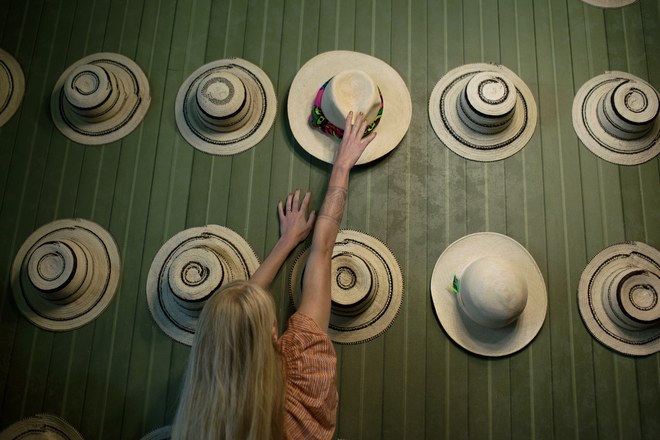It’s a scorching day in Panama City, over 90 degrees and with so much humidity we can’t help but laugh about our fogged-up sunglasses and matted-down hair—but the scenery more than makes up for it. I’m with Gigi Burris, the milliner extraordinaire and former CFDA/Vogue Fashion Fund finalist, and we are perusing the shops in Casco Viejo, looking for hand-carved wooden figurines and antique maps of the Panama Canal. This is the old part of town that’s a little decrepit and overgrown but retains the charm of a scene out of a John le Carré or James Bond novel. You can see downtown’s glass skyscrapers in the background, but wandering through this cobblestoned neighborhood, you might encounter a president or a spy or a pirate around any corner. You never know—Panama has an interesting history like that.
We’re here as part of Burris’s collaboration with W Hotels to promote its new, gleaming, high-design hotel here. It’s a well-suited partnership, ideal for Burris to explore the country’s unique connection to hats and design, and will result in a capsule collection of Panama-inspired toppers for W to sell online and in select hotels.
I meet Burris in the hotel lobby, which is decorated with brilliant swaths of fabrics from the local Emberá tribe. We hug, catch up on the requisite gossip—all the necessaries for two New Yorkers meeting up abroad—and start to discuss what attracted her to Panama. As she explains, any milliner worth her weight in salt knows that Panama hats actually have very little to do with Panama. The style originated in Ecuador, and it was Americans like Theodore Roosevelt, who merely wore them in Panama, that popularized the association. The real story, she tells me, had to do with the country’s amazing indigenous traditions of color and design. “I want to get to the bottom of all these fabrics,” she continues, running her hand over a particularly crimson square on the wall. “I can’t believe the color on these.”
The hotel arranges for us to visit the Emberá tribe and getting to the village is not easy. It involves driving out of the city, traversing a network of dirt roads, and going by canoe through a labyrinth of low-slung mangrove forests. Dozens and dozens of monkeys swing within inches of our heads, and our guide warns us that the white-headed capuchins are especially pesky and like to snatch loose items like hats. “Maybe this should inspire you to add chin straps to all your hats,” I tell Burris, “that way, monkeys in the jungle can’t steal them.” The risk of having her hat swiped does not prevent her from going to the bow of the boat to snap an Instagram pic of a capuchin.
When we finally arrive at the village, the women are wearing multicolor skirts and brilliant tops made from interlocking metal coins. We spend the morning talking about rural life, as well as the history and messages imbued in every fabric’s design—this one stands for fertility, that one indicates a particular village’s location, and so forth. Many use the traditional mola technique, our Emberá host tells us, a sort of reverse appliqué where several layers of contrasting colors are sewn together, then a pattern is formed by excising concentric shapes from each layer. The more layers, the more precise and invisible the stitching and the more brilliant the colors, the finer the mola. Our host goes on to explain the painstaking process by which foraged ingredients are used to saturate fabrics with color. Deep blues, electric magentas, and delicate shades of sage—all from various flowers, roots, and a thousand other secret sources. “The fabrics they make here are just gorgeous,” Burris says. “It’s amazing to me that they can achieve such intensity of color using only materials they find in the forest. The colors are out of this world. You can’t even imagine how bright they are.”
But our visit to the Emberá village yields another form of inspiration that we hadn’t anticipated. Here in the jungle, many of the women wear extravagant flower crowns, made of hand-beaded headbands adorned with a single lush hibiscus blossom. “But they aren’t like anything you’d see at Coachella,” Burris notes. “They’re actually quite elegant.” We start bouncing ideas back and forth, discussing fabrications, colorways, and how she might translate something like that into a commercial design back home. That’s precisely the value in coming on trips like this. Come for one thing and discover another—you never know what inspiration is waiting to be found, whether it’s on a cobblestone street or in a remote jungle village.
Source: Vogue Todd Plummer
